By Megan Gorrey
Outside a café near Kogarah train station in Sydney’s south, retiree Ken Bowles eats a bowl of chicken soup as he scans the newspaper. In the run-up to the NSW election, Bowles cites his biggest concerns as the parlous state of roads, long hospital wait times and surging living costs.
“This soup I’m eating has gone up $5 or $6 in a matter of months,” Bowles said.
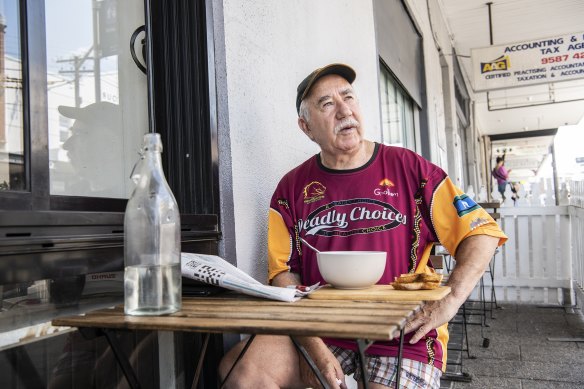
Ken Bowles says federal matters, particularly the proposed Indigenous Voice to parliament, will inform how he votes in the knife-edge seat of Kogarah in the state election. Credit: Steven Siewert
Four weeks from the state election, he’s yet to decide who is best placed to tackle the problems.
It’s shaping up to be the closest contest in decades. Premier Dominic Perrottet faces an uphill battle to win a fourth term for the Coalition, while Labor will need to win nine seats on a swing of 6.2 per cent to form a majority government.
Bowles said he faces a difficult choice at the voting booth: “I’ll close my eyes and pick, and it shouldn’t be like that.
“I’m sitting on the fence, but I don’t think whichever side I fall on will be the one I want.”
The March poll will concentrate attention on the knife-edge suburban electorates of Kogarah and East Hills. Changes to electoral boundaries have whittled slim margins in Labor leader Chris Minns’ seat of Kogarah, and Liberal-held East Hills in the south-west, to a hair’s breadth of 0.1 per cent.
The upshot is Minns, who first won the seat in 2015 with a 5.4 per cent margin, faces the challenge of snatching the state’s top job from Perrottet whilst defending Labor’s most marginal seat.
East Hills – the Liberals’ most marginal electorate – is among a swath of narrowly held seats in south-western and western Sydney that will be crucial to the Perrottet government’s electoral fortunes.
Psephologist Ben Raue, who runs The Tally Room blog, said: “I think both sides can win this election. I’d probably feel better to be in Labor’s position than the Coalition’s position right now.
“But that’s not to say any of this is decisive. The whole thing is definitely in play.”
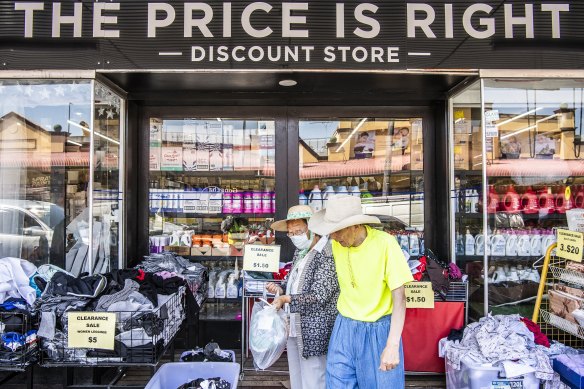
Residents face cost-of-living pressures in Kogarah in Sydney’s south, which is Labor’s most marginal seat. Credit: Steven Siewert
The electorate of Kogarah, which includes the suburbs of Beverly Hills, Kingsgrove, Hurstville, Bexley and Carlton, has been held by an uninterrupted run of Labor candidates since 1953. Minns nearly lost the seat in 2019 after then Labor leader Michael Daley’s remarks about people “from Asia with PhDs” taking the jobs of young Australians emerged late in the campaign. There was a 5 per cent swing away from Labor in the electorate, where 30 per cent of residents have Chinese ancestry.
More recently, a boundary redistribution, which added affluent pockets of the Kogarah Bay and Blakehurst waterfronts shrank Minns’ margin from 1.8 per cent to an estimated 0.1 per cent.
Minns is keenly aware Labor must retain the seat.
“I’ve always said we need to win Kogarah to win government,” he said.
Gaming industry whistleblower Troy Stolz, who has terminal cancer, joined the race as a “reform pokies independent” to highlight the opposition leader’s failure to back poker machine reform. The Liberals have endorsed former City of Sydney councillor Craig Chung, who grew up in Kogarah Bay, to contest the seat.
Stolz thought the major parties were unfamiliar with the struggles of Kogarah voters, who were concerned with living expenses, hospital waiting times, nurse-to-patient ratios, and M5 toll road costs.
“I don’t think Liberal or Labor appreciate how much communities are hurting from the financial pressures because they’re in their ivory towers, and they’re dealing with internal disputes,” Stolz said.
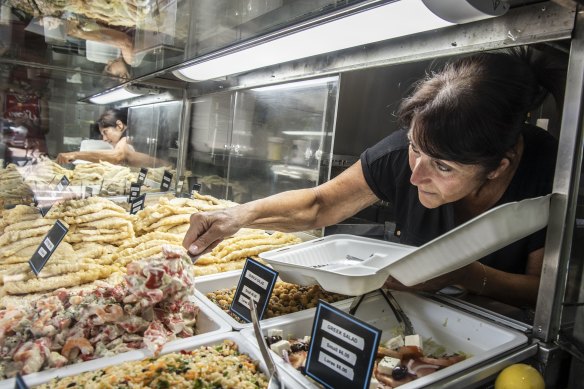
FishoHolics employee Anje Kay says pensioners were cutting back on food spending. Credit: Steven Siewert
Asked what problems were frustrating voters, Minns reported a similar list of concerns: rising living costs and electricity prices, road tolls, and emergency department waiting times, and privatisation.
On the Railway Parade shopping strip, FishoHolics employee Anje Kay said she had noticed elderly pensioners struggling to make ends meet.
“They’re just not going to be able to eat soon. They’re coming in and getting one scallop, one fish cocktail. The cost of everything’s going up, but the pension is not.”
Kay was a Liberal supporter, but she intends to vote for Labor next month.
“Let’s hope they change things. The Liberals were there for their own pockets and they did nothing for us.”
Bowles said he preferred not to vote for Labor due to Prime Minister Anthony Albanese’s push for an Indigenous Voice to parliament, which he viewed as unnecessary and lacking in detail.
“I told Chris [Minns] I probably won’t vote for him. For me, federal Labor’s actions are interfering with the state. It’s not Chris’s fault, but they have to bear the brunt of it.”
Asked what he thought of Perrottet, Bowles said: “I’d prefer Gladys [Berejiklian].”
Raue thought it was unlikely that Labor would experience a similar result to 2019 in Kogarah, and said Minns’ incumbency and role as opposition leader would probably give him a boost at the polls.
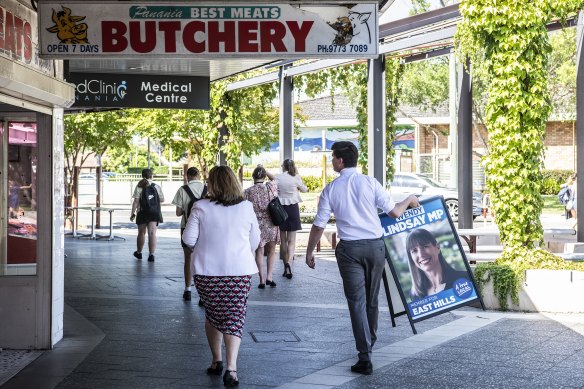
Liberal incumbent Wendy Lindsay is seeking re-election in suburban East Hills, where the conservative vote has risen.Credit: Steven Siewert
“I think Minns will probably get a comfortable swing towards him and be fine,” Raue said.
The battle is expected to be more intense in East Hills, also on the northern side of the Georges River, an area that has increasingly tended to vote for the Liberals in state and federal elections.
The electorate is also considered a must-win for Labor. It was one of the most closely contested seats in 2019, when first-term Liberal candidate Wendy Lindsay won by less than 1 per cent of the vote.
Boundary changes have meant East Hills gained several thousand voters in Bass Hill from the Labor stronghold of Bankstown, cutting the Liberal margin from 0.5 per cent to an estimated 0.1 per cent.
It’s the Liberals’ most marginal electorate. Lindsay faces a challenge from Labor’s Kylie Wilkinson for the seat, which includes Milperra, Revesby, Padstow, Picnic Point and Padstow Heights.
Raue said shifting demographics and the growing popularity of East Hills’ waterfront homes – typically a sign of Liberal voters in Sydney – contributed to a widening political divide in the area.
“The north of the seat tends to be a lot more Labor-voting, and the south of the seat tends to be a lot more Liberal-voting. That’s a trend that’s developed over time,” he said. “It’s possible it’s becoming more conservative, but it’s still an area where Labor can win.”
Not far from the riverfront properties dotted with Australian flags and Liberal Party lawn signs in East Hills, Panania Florist owner Cheryl Beswick said Lindsay had “a big impact” on the electorate.
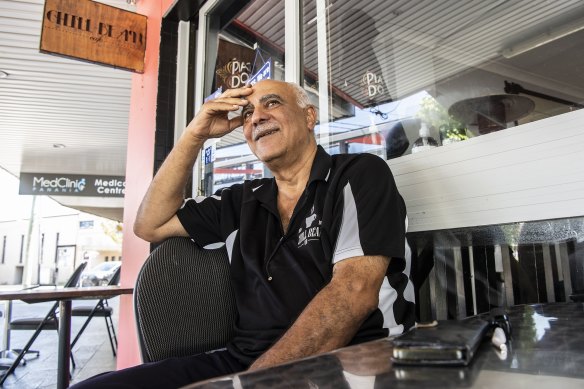
Cafe owner and undecided voter Sam Tarmagi wants relief for small business owners. “Prices are going up and up and up, it doesn’t stop. Chicken, eggs, meat, vegetables, electricity, gas. We need some movement from the government.”Credit: Steven Siewert
“She’s not one that only comes out at election time.”
Chill Bean Cafe owner Sam Tarmagi said he hadn’t decided on his vote. He wants more help for local businesses after he was forced to shed workers following a 40 per cent drop in income since 2020.
“I have to see what they’re going to promise us. I want some support for small businesses, not only for my business, for every business,” Tarmagi said.
Lindsay was hopeful locals would back her for another term. She said maintaining a strong economy would be vital to easing pressure on household budgets and investing in infrastructure and services.
“I have fought hard for the people of East Hills every day to ensure that our once-forgotten corner of Sydney gets its fair share,” Lindsay said.
Wilkinson said Labor wasn’t “taking a single vote for granted”.
“It’s clear it’s time for a fresh start in East Hills.”
Raue said a swath of mostly marginal seats, including East Hills, Leppington, Penrith, Parramatta, and Winston Hills among others in western Sydney would be the ones to watch on election night.
“It’s going to be an interesting election. I would bet on Labor, but I wouldn’t bet much,” Raue said.
The Morning Edition newsletter is our guide to the day’s most important and interesting stories, analysis and insights. Sign up here.